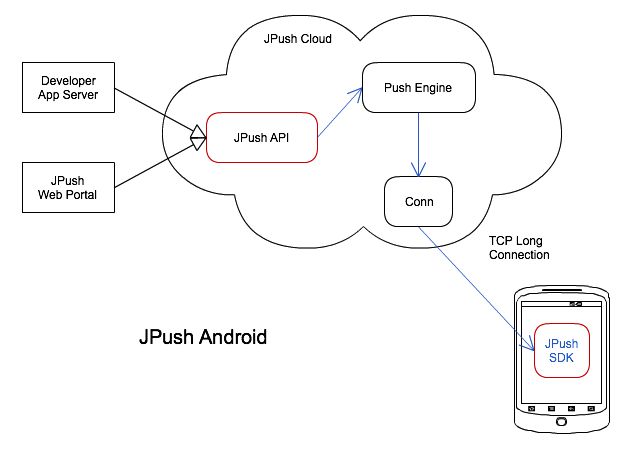极光推送JPush使用Java SDK开发
一、极光推送是什么?
极光推送消息介绍
上面是极光官方文档的介绍说明,作为初次使用者。如果对于官方文档解释看不明白的,可以多去网上找一些通俗易懂的博客文章之类的,然后再去看官方文档,最后再按需要进行集成调试和开发等。
简单来说:极光推送是一个免费的开源的手机APP消息推送平台(类似帅哥美女们常用的购物APP某宝、某东等,一些优惠券消息后台推送到你们手机上)。它集成了包括:SDK给客户端、JPush API给服务端、JPush Cloud服务器代理推送消息。一张图看懂整个逻辑(极光官方):
![]()
android和ios的区别在于,ios需使用apple APNS server专用服务代理。(这可能是米国佬的专业独裁吧)
二、使用Java SDK集成开发(服务端)
1、生成Appkey 和 MasterSecret
关于Appkey 和 MasterSecret 的介绍,这里只作简单说明:极光平台推送到对应的注册APP手机客户端所需要的参数;创建测试用的Appkey和MasterSecret的步骤和操作介绍可以去官网取经,或查阅其他博客文章等,一般作为服务器后台开发是不需要关心这个(客户端androi、ios开发者负责创建)。
AppKey和MasterSecret操作步骤
2、添加依赖jar包
笔者的项目使用的是SpringCloud微服务架构,自然使用的是Maven仓库。所以,首先需要添加maven依赖
cn.jpush.api
jpush-client
3.3.9
版本以3.3.9为例,目前最新版本出到3.3.12了,一般不建议使用最新版本,因为最新版本的东西都不太稳定。
3、集成Java SDK推送方法JPush
//极光推送至App端
String title = record.getTitle(); //标题
String contents = record.getContents(); //内容
if(StringUtils.isEmpty(MasterSecret) || StringUtils.isEmpty(AppKey)){
commonResponse.setCode(MsgReturnCode.APPKEY_MASTERSECRET_EXCEPTION.code);
commonResponse.setMessage(MsgReturnCode.APPKEY_MASTERSECRET_EXCEPTION.message);
return commonResponse;
}
PushResult pushResult = push(String.valueOf(title),contents);
if(pushResult != null && pushResult.isResultOK()){
log.info("针对别名" + title + "的信息推送成功!");
commonResponse.setCode(CommonResponse.SUCCEE);
commonResponse.setMessage("信息推送成功!");
return commonResponse;
}else{
log.info("针对别名" + title + "的信息推送失败!");
commonResponse.setCode(MsgReturnCode.SYSTEM_EXCEPTION.code);
commonResponse.setMessage("信息推送失败!");
return commonResponse;
}上面的 String title = record.getTitle(); //标题
String contents = record.getContents(); //内容
就是推送的某条消息到用户手机上,所要展示的标题和内容。
- JPushClient 调用集成SDK的推送方法sendPush();
- 生成极光推送对象PushPayload
/**
* 极光推送方法(采用java SDK)
* @param title
* @param contents
* @return PushResult
*/
public PushResult push(String title,String contents){
ClientConfig clientConfig = ClientConfig.getInstance();
JPushClient jpushClient = new JPushClient(MasterSecret, AppKey, null, clientConfig);
PushPayload payload = buildPushObject_android_ios_alias_alert(title,contents);
try {
return jpushClient.sendPush(payload);
} catch (APIConnectionException e) {
log.error("Connection error. Should retry later. ", e);
return null;
} catch (APIRequestException e) {
log.error("Error response from JPush server. Should review and fix it. ", e);
log.info("HTTP Status: " + e.getStatus());
log.info("Error Code: " + e.getErrorCode());
log.info("Error Message: " + e.getErrorMessage());
log.info("Msg ID: " + e.getMsgId());
return null;
}
} /**
* 生成极光推送对象PushPayload(采用java SDK)
* @param title
* @param contents
* @return PushPayload
*/
public PushPayload buildPushObject_android_ios_alias_alert(String title,String contents){
return PushPayload.newBuilder()
.setPlatform(Platform.android_ios())
.setAudience(Audience.all())
.setNotification(Notification.newBuilder()
.addPlatformNotification(AndroidNotification.newBuilder()
.addExtra("type", "infomation")
.setTitle(title)
.setAlert(contents)
.build())
.addPlatformNotification(IosNotification.newBuilder()
.addExtra("type", "infomation")
.setAlert(contents)
.build())
.build())
.setOptions(Options.newBuilder()
.setApnsProduction(false)//true-推送生产环境 false-推送开发环境(测试使用参数)
.setTimeToLive(90)//消息在JPush服务器的失效时间(测试使用参数)
.build())
.build();
}
.setPlatform(Platform.android_ios())
设置要推送的客户端的平台android、ios;可以单独设置android或ios;我这里就都设置了。
.setAudience(Audience.all())
设置要推送的目标群用户,按照各自业务区分需要,推送给目标群用户,我这里设置全部用户了。
.addPlatformNotification(AndroidNotification.newBuilder()
.addExtra("type", "infomation")
.setTitle(title)
.setAlert(contents)
.build())
.addPlatformNotification(IosNotification.newBuilder()
.addExtra("type", "infomation")
.setAlert(contents)
.build())设置安卓和ios平台的推送消息标题和内容。整个后台服务api接口开发就结束了,看着非常简单;因为极光本身集成了强大的SDK供用户使用,我们只需要引入jar依赖即可调用SDK中的方法,还有另一种单独调用极光服务的api开发,那个会稍微复杂点,当然对其原理的理解也会更加深入点。
三、在安卓和ios客户端对接
上面已经说了需要创建appKey和masterSecret。服务端跟客户端对应同一套参数,这样保证推送消息一致。
跟客户端的联调开发就不赘述了,这里只强调保证appKey和masterSecret参数一致就行了。
觉得对你有帮助,关注博客和公众号。不定期分享最新前沿技术框架和bat大厂常用技术等,加群不定期分享行业内大牛直播讲课以及获得视频课件资料等。
